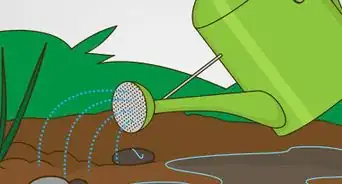This article was co-authored by Mike Garcia. Mike Garcia is a Licensed Landscape Contractor and the Founder of Enviroscape LA, a full-service landscape design and construction firm in Los Angeles, California. With over 30 years of experience, Mike specializes in sustainable landscape practices. Mike holds an Ornamental Horticulture degree, C-27 Landscape Contractor and D-49 Tree Service Contractor licenses, and Permaculture Design, California Naturalist, International Certified Professional Pond Contractor, and Pond Building certifications. He is one of eight Internationally Certified Pond Builders in the world. Enviroscape LA has won landscape and water feature awards from the International Professional Pond Contractors Association (IPPCA), National Association of Pond Professionals (NAPP), and the California Landscape Contractors Association (CLCA). Mike is a past president of the CLCA and currently serves on their local Board of Directors. Enviroscape LA has been featured in PONDS USA Magazine, Pond and Garden Lifestyles Magazine, and the Los Angeles Times. Mike has appeared on Extreme Home Makeover, HGTV's Landscapers Challenge, and A & E's series Fix That Yard.
There are 7 references cited in this article, which can be found at the bottom of the page.
wikiHow marks an article as reader-approved once it receives enough positive feedback. In this case, 91% of readers who voted found the article helpful, earning it our reader-approved status.
This article has been viewed 241,711 times.
Coconut trees are lovely plants that produce tasty fruit. They grow naturally in tropical climates, but you can also plant one at home. Whether you plan to grow your coconut tree outside or as a houseplant, it’s an easy process that will produce a charming addition to any yard or home.
Steps
Germinating Your Coconut Seed
-
1Choose the perfect nut to incubate. The ideal nut will have lots of water inside that will slosh around when you shake it.[1] Make sure that the nut still in its husk.
- You can use a coconut that has dropped to the ground or one from a store.
-
2Place the coconut in a bucket of lukewarm water. Use a stone or weight to keep the coconut submerged. Leave the nut in the bucket for 3-4 days.[2]
- This process will soften the coconut and accelerate the germination process.
Advertisement -
3Fill a zip-lock plastic bag with 1 cup (240 mL) of water. Place the nut in the bag and seal it. Store the bag in a warm, dark location for up to 3 months.
- An example of a good place to store the coconut is by a water heater.[3]
-
4Check on the coconut every week for germination. Once the nut has sprouted and started to grow roots, gently wrap a damp paper towel around the roots and place the seed back into the bag.[4]
- The seed will be fully developed when the sprout is approximately as long as your finger and the roots have reached a length of 6 inches (15 cm) to 8 inches (20 cm).[5]
Planting Your Tree
-
1Mix your planting soil. Use a mixture of half potting soil and half sand. Also add some fine gravel or vermiculite to help aerate the soil.[6]
-
2Put the germinated coconut in the soil. Place the nut into the soil with the pointed end down.[9] Make sure that 1/3 of the coconut sticks out of the soil.
- If you are planting your tree inside, use a pot that is at least 10 inches (25 cm) deep and has a diameter large enough to accommodate the seed.[10]
-
3Give your coconut tree plenty of water and sunlight. Water the tree at least 2 times per week so the soil is moist but not too wet.[11] Make sure that the tree gets lots of light, but not constant brightness. Some shade is preferable.[12]
- For outdoor plants, you can make a mini greenhouse. Put bamboo stakes into the ground around the tree. Wrap plastic wrap around the sticks and across the top. Remove the greenhouse when the tree is 1 foot (0.30 m) tall.[13]
- Keep indoor trees moist by spraying both sides of the leaves with water.[14]
Maintaining Your Tree
-
1
-
2Fertilize your plant after 1 year. After the first year, use a rotary spreader to apply fertilizer at a rate of 1 pound (0.45 kg) per 100 square feet (9.3 m2). Use a fertilizer that is rich in certain nutrients, including boron, manganese, and magnesium.[17]
- During the first year of growth, the tree will absorb nutrients from inside the nut.[18]
-
3
Community Q&A
-
QuestionWhy are my tree's leaves not dark green?
 Bridgett BarrettCommunity AnswerUsually, this means it's not getting enough sunlight. Try moving your tree to a sunnier spot.
Bridgett BarrettCommunity AnswerUsually, this means it's not getting enough sunlight. Try moving your tree to a sunnier spot. -
QuestionCan I grow a small coconut tree indoors?
 CharlesBSingsCommunity AnswerYes, but if you grow it indoors, it will not produce coconuts, and its height will be around 5'.
CharlesBSingsCommunity AnswerYes, but if you grow it indoors, it will not produce coconuts, and its height will be around 5'. -
QuestionWhy is my coconut plant turning yellow?
 CharlesBSingsCommunity AnswerCoconut fronds turn yellow if the soil is lacking nutrients, but there are some occasions where a pest or fungus could be causing your coconut fronds to turn yellow.
CharlesBSingsCommunity AnswerCoconut fronds turn yellow if the soil is lacking nutrients, but there are some occasions where a pest or fungus could be causing your coconut fronds to turn yellow.
Warnings
- Coconut trees are susceptible to certain diseases. One of these diseases is known as Lethal Yellow.[21] Lethal Yellow is mostly found in trees in Florida. Signs of Lethal Yellow include yellowing leaves, dropping fruit, and slow death.[22] Lethal Yellow can be treated with antibiotics.⧼thumbs_response⧽
- If a tree becomes infected with disease or fungus, it is best to remove the affected tree.⧼thumbs_response⧽
- Coconut tree can also be affected by fungal bud rot. Signs of this infection are gray, foul-smelling leaves. This fungus is most common in poorly draining soil and after heavy rains.[23]⧼thumbs_response⧽
References
- ↑ https://www.ctahr.hawaii.edu/oc/freepubs/pdf/OF-25.pdf
- ↑ https://www.gardeningchannel.com/how-to-grow-coconut-palm/
- ↑ https://www.gardeningchannel.com/how-to-grow-coconut-palm
- ↑ https://www.gardeningchannel.com/how-to-grow-coconut-palm
- ↑ https://www.gardeningchannel.com/how-to-grow-coconut-palm
- ↑ https://www.rootwell.com/blogs/coconut-tree
- ↑ https://www.gardeningchannel.com/how-to-grow-coconut-palm
- ↑ http://www.gardena.com/ie/garden-life/garden-magazine/grow-your-own-coconut-palm/
- ↑ https://www.ctahr.hawaii.edu/oc/freepubs/pdf/OF-25.pdf
- ↑ https://www.ctahr.hawaii.edu/oc/freepubs/pdf/OF-25.pdf
- ↑ https://www.ctahr.hawaii.edu/oc/freepubs/pdf/OF-25.pdf
- ↑ https://www.ctahr.hawaii.edu/oc/freepubs/pdf/OF-25.pdf
- ↑ https://www.gardeningchannel.com/how-to-grow-coconut-palm
- ↑ http://www.gardena.com/ie/garden-life/garden-magazine/grow-your-own-coconut-palm/
- ↑ https://www.ctahr.hawaii.edu/oc/freepubs/pdf/OF-25.pdf
- ↑ Mike Garcia. Licensed Landscape Contractor. Expert Interview. 20 November 2020.
- ↑ https://www.rootwell.com/blogs/coconut-tree
- ↑ https://www.ctahr.hawaii.edu/oc/freepubs/pdf/OF-25.pdf
- ↑ https://www.gardeningchannel.com/how-to-grow-coconut-palm
- ↑ https://www.ctahr.hawaii.edu/oc/freepubs/pdf/OF-25.pdf
- ↑ https://www.gardeningchannel.com/how-to-grow-coconut-palm
- ↑ https://www.gardeningchannel.com/how-to-grow-coconut-palm
- ↑ https://www.gardeningchannel.com/how-to-grow-coconut-palm
- ↑ https://www.gardeningchannel.com/how-to-grow-coconut-palm/
- ↑ https://www.gardeningchannel.com/how-to-grow-coconut-palm/
- ↑ https://www.gardeningchannel.com/how-to-grow-coconut-palm/
- ↑ https://www.gardeningchannel.com/how-to-grow-coconut-palm
About This Article
If you want to grow a coconut tree, place your coconut in a bucket of lukewarm water for 3-4 days to soften it. After the coconut has softened, place it into a resealable plastic bag with 1 cup of water and store it in a warm, dark location until it grows a sprout and roots. Once it germinates, wrap the roots in a damp paper towel and place the seed back into the bag until the roots are about 6 inches deep, then plant the nut so that about a third of the coconut sticks out of the soil. Water the tree twice a week and place it in partial sun. For more tips, including how to maintain your tree once it's planted, read on!































































